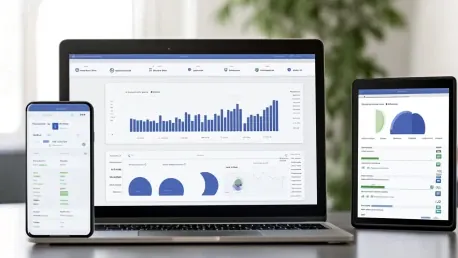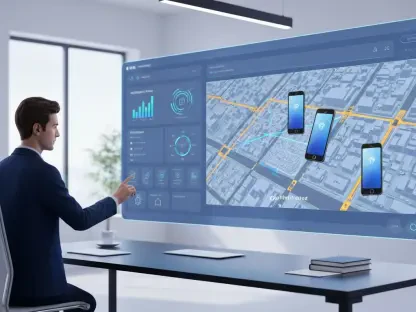In today’s fast-paced business environment, the ability to make informed decisions quickly is paramount. Chief Data Officers (CDOs) and Chief Information Officers (CIOs) are at the forefront of this challenge, leveraging advanced data visualization tools to gain comprehensive insights. This article delves into the importance of connected data visualization, the role of CDOs and CIOs, and the methodologies that enable high-quality, real-time information access.
The Need for Real-Time and High-Quality Information
The Dynamic Business Environment
Businesses today operate in a dynamic environment where rapid decision-making is crucial. The ability to access high-quality information in real-time can significantly impact an organization’s success. Data-driven insights are no longer a luxury but a necessity for staying competitive. The speed at which markets change, customer preferences evolve, and new competitors emerge demands that organizations remain agile, capable of pivoting their strategies based on the most current and accurate data available. Hence, having real-time access to high-quality data empowers leaders to make decisions that can lead to immediate improvements in operations and strategy.
Organizations that harness the power of real-time data can anticipate market trends, optimize internal processes, and enhance customer experiences. This dynamic business environment forces companies to be proactive rather than reactive, allowing them to seize opportunities swiftly and mitigate potential risks effectively. For this reason, connected data visualization stands out as an indispensable tool in the modern enterprise, enabling decision-makers to see the bigger picture and act on insights with unprecedented speed and precision.
Investment in Analytics Tools
The investment in analytics tools and platforms has seen a significant increase. According to a Capgemini Research Institute report, investment in these tools is projected to rise from 54% in 2020 to 76% in 2024. This surge underscores the critical role of analytics in modern enterprises, with executives leveraging data to develop new products and services. This trend reflects a growing recognition of the value that advanced analytics can bring to various aspects of business operations, from enhancing customer insights to streamlining supply chains and improving overall decision-making processes.
Moreover, as the volume of data generated by businesses continues to grow exponentially, the need for robust analytics platforms becomes even more pressing. These tools are not just about handling large datasets; they offer a means to derive meaningful insights that drive innovation and strategic growth. By investing in state-of-the-art analytic tools, organizations position themselves to better understand and anticipate the needs of their customers, optimize their operational efficiencies, and ultimately gain a competitive edge in their respective industries.
The Role of CDOs and CIOs
Driving the Analytics Agenda
Chief Data Officers and Chief Information Officers play a pivotal role in driving the analytics agenda within their organizations. An AWS survey reveals that these officers spend more than a fifth of their time enabling new business ventures through analytics. Their strategic decision-making and innovation are crucial for organizational growth. CDOs and CIOs are tasked with not only implementing cutting-edge technologies but also fostering a data-driven culture across their enterprises, ensuring that data insights are integrated into every facet of the business.
Their role extends beyond merely overseeing data infrastructure; they are also responsible for harnessing data to derive actionable insights that can lead to new market opportunities and improved business processes. By promoting the use of advanced analytics tools and connected data visualizations, these officers help their organizations turn raw data into powerful insights that drive innovation and create value. Their efforts are essential in bridging the gap between technical data capabilities and business objectives, ensuring that data serves as a catalyst for strategic expansion and operational excellence.
Overcoming Challenges in Delivering Insights
Despite their efforts, business leaders often struggle with the timely delivery of insights due to the complexity and volume of data. Traditional business intelligence (BI) and data visualization tools frequently fall short when dealing with complex and unstructured data, leaving essential context out of the decision-making process. The challenge is intensified by the fact that data sources are often siloed within different departments, making it difficult to piece together a comprehensive and cohesive picture of the business environment.
To overcome these hurdles, CDOs and CIOs must adopt a more integrated approach to data management and visualization, one that leverages innovative tools capable of harmonizing disparate data sources. By implementing advanced data visualization solutions that facilitate the seamless integration of structured and unstructured data, business leaders can ensure that insights are not only timely but also contextually rich and actionable. These tools can help reveal hidden patterns and connections within the data, providing a more holistic view that is essential for informed decision-making and strategic planning.
The Importance of Comprehensive Insight
Incorporating Various Data Aspects
In an interconnected business landscape, organizations must incorporate time-based, location-based, and relationship-based data into their analysis. This comprehensive approach helps analytics leaders and CIOs understand complex relationships within their data, which is crucial for deriving actionable and strategic insights. By integrating these various dimensions of data, enterprises can achieve a more nuanced understanding of their operations, customer behavior, and market dynamics, leading to more informed and effective decision-making processes.
The inclusion of time-based data allows organizations to track and analyze trends over specific periods, providing a temporal context that can reveal seasonality, growth patterns, and other critical temporal dynamics. Location-based data adds a geographical dimension, helping businesses understand regional differences and optimize their operations accordingly. Relationship-based data, on the other hand, uncovers connections between different data points, enabling organizations to identify correlations and dependencies that might not be immediately apparent. Combining these aspects within a connected data visualization framework can thus unlock deeper, more valuable insights, driving strategic advantage and competitive differentiation.
Visualizing Interconnected Data
Visualizing interconnected data is an emerging trend that improves strategic foresight and operational efficiency. Such visualization methodologies allow organizations to uncover hidden patterns, trends, and relationships that conventional tools might miss, enhancing the overall decision-making process. By utilizing advanced visualization techniques, businesses can transform raw, complex data into intuitive visual representations that make it easier for stakeholders to understand and act upon the insights derived from the data.
This approach not only enhances the clarity and accessibility of data but also enables more effective communication and collaboration across different teams and departments. When data is visualized in a coherent, interconnected manner, it becomes a powerful tool for aligning organizational efforts towards common goals. Decision-makers can quickly identify key trends and anomalies, predict future outcomes, and develop strategies that are grounded in a comprehensive understanding of the business landscape. Moreover, by continually refining and updating their visualization methodologies, organizations can stay ahead of market shifts and make proactive, rather than reactive, decisions.
Trends in Data Analytics
Increased Sophistication in Tools
The business community recognizes the significance of advanced data analytics tools in enabling comprehensive insights. There is a clear consensus that traditional BI tools must evolve to accommodate complex data structures and unstructured data sources. This evolution is necessary to keep pace with the growing complexity of data generated by modern businesses, which spans a wide array of formats and sources. Advanced analytics tools are designed to manage this complexity, offering enhanced capabilities for data integration, processing, and analysis that go beyond the limitations of traditional BI solutions.
The evolution of these tools is driven by advancements in technologies such as artificial intelligence (AI) and machine learning (ML), which enable more sophisticated data analysis and predictive modeling. By leveraging these cutting-edge technologies, businesses can gain deeper insights into their data, uncovering patterns and trends that would be difficult or impossible to detect using conventional methods. Furthermore, the increased sophistication of analytics tools supports more interactive and dynamic visualization capabilities, allowing users to explore data in new and innovative ways.
The Shift Towards Advanced Visualization
There is a growing trend towards visualizing connected data to improve strategic foresight and operational efficiency. This shift is driven by the need to uncover hidden patterns, trends, and relationships that conventional tools might miss, thereby enhancing the overall decision-making process. Advanced visualization techniques enable businesses to represent data in more interactive and intuitive formats, making it easier for stakeholders to analyze and interpret complex datasets.
The move towards advanced visualization is also fueled by the increasing availability of powerful visualization software and platforms that offer a wide range of customization and interactivity options. These tools allow organizations to create visualizations that are tailored to their specific needs and requirements, providing a more accurate and comprehensive view of the data. By adopting advanced visualization techniques, businesses can gain a better understanding of their operations, identify areas for improvement, and make more informed strategic decisions that drive growth and success.
Addressing Challenges with Advanced Tools
Enhancing Data Quality and Decision Timeliness
The necessity for a broader picture that encapsulates various data aspects is emphasized. The article advocates for the immediate and thorough understanding of enterprise data to support rapid and informed decisions. Advanced tools that can capture and visualize complex, interconnected data are recommended. These tools provide a more holistic view of the data, enabling decision-makers to see the relationships between different data points and make more informed decisions.
Enhancing data quality and decision timeliness requires not only the right tools but also a cultural shift towards embracing data-driven decision-making. Organizations need to invest in training and developing their workforce to understand and effectively utilize these advanced tools. By fostering a data-centric culture, businesses can ensure that data insights are integrated into every level of the decision-making process. This approach not only improves data quality but also accelerates the speed at which insights are generated and acted upon, leading to more agile and responsive business strategies.
Making Sense of Unstructured Data
Sophisticated visualization tools are essential for making sense of unstructured data sources. These tools enhance the strategic decision-making ability of leaders across sectors like healthcare and finance, enabling them to derive actionable insights from complex data sets. Unstructured data, which includes sources such as social media posts, customer reviews, and sensor data, can provide valuable insights into customer behavior, market trends, and operational performance. However, traditional BI tools often struggle to handle unstructured data due to its complexity and variability.
Advanced visualization tools address this challenge by offering robust data processing and integration capabilities that can handle both structured and unstructured data. By converting unstructured data into structured formats that can be easily analyzed and visualized, these tools enable businesses to extract meaningful insights from all available data sources. This comprehensive approach to data analysis not only improves the accuracy and relevance of insights but also empowers organizations to make more informed and effective decisions.
Practical Applications and Benefits
Healthcare and Research
In healthcare and research, visualizing connected data can significantly enhance the understanding of interrelationships within an enterprise. Practical scenarios demonstrate how visuals help decode data in context, facilitating a more nuanced understanding and better communication between technical and non-technical stakeholders. For example, in clinical trials, visualizing patient data over time and across different geographical locations can help identify trends and patterns that inform treatment strategies and improve patient outcomes.
Moreover, connected data visualization can support predictive analytics, enabling healthcare providers to anticipate and address potential health issues before they become critical. By integrating various data sources such as electronic health records, lab results, and patient feedback, advanced visualization tools can provide a comprehensive view of patient health, leading to more personalized and effective care. This approach not only improves patient outcomes but also enhances operational efficiency, reducing costs and optimizing resource allocation across healthcare facilities.
Strategic Decision-Making
Visualizing data within context allows for better trend identification, risk mitigation, and knowledge sharing. This approach is crucial for strategic decision-making, enabling organizations to uncover hidden insights and make informed decisions effectively. For instance, in the financial sector, visualizing market data, customer behavior, and regulatory changes together can help financial institutions identify emerging risks and opportunities, develop more robust investment strategies, and ensure compliance with regulatory requirements.
By presenting data in a clear and intuitive format, connected data visualization enables decision-makers to quickly grasp complex information and make informed decisions that align with organizational goals. This ability to visualize and analyze data in a comprehensive manner fosters a more collaborative and informed decision-making process, facilitating better communication and alignment across different departments and teams. Ultimately, this leads to more strategic, data-driven decisions that drive business growth and success.
Conclusion
In today’s fast-paced business environment, making informed decisions swiftly is crucial. Chief Data Officers (CDOs) and Chief Information Officers (CIOs) are at the forefront of this challenge, utilizing advanced data visualization tools to obtain comprehensive insights. The ability to access and interpret quality data in real time is essential for staying competitive and responsive to market changes.
CDOs and CIOs use connected data visualization to create a cohesive, real-time view of their operations. This connectivity allows them to piece together data from multiple sources, transforming raw data into actionable intelligence. Through these advanced visualization techniques, they enable their organizations to predict trends, identify opportunities, and mitigate risks more effectively.
This article explores the significance of connected data visualization, emphasizing the pivotal roles of CDOs and CIOs, and outlines the methodologies that ensure high-quality, immediate access to information. Their expertise in navigating complex data landscapes ensures businesses can make swift, informed decisions, driving success and innovation.









